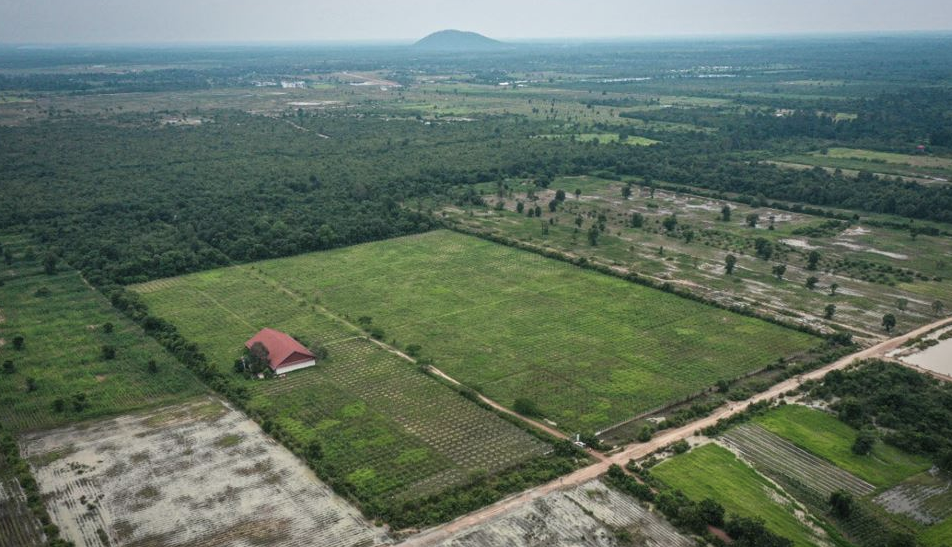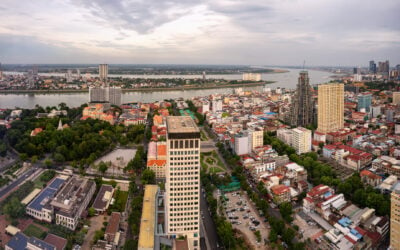When Mark Twain famously quipped, “Buy land, they’re not making it anymore,” he captured something fundamental about real estate investment that remains true today.
Land is finite. Its scarcity gives it lasting appeal. And yet, despite this obvious logic, land remains one of the most misunderstood and underutilized investment vehicles available.
Many potential investors are put off by land’s perceived complexity, potential legal hurdles, and questions about safety and returns.
They worry about liquidity issues, zoning regulations, and whether they’ll actually see any profit before they’re old and gray. These concerns aren’t entirely unfounded, but they often prevent people from exploring what can be a remarkably stable and profitable strategy.
Every investment is a calculated risk – a bet that an asset will grow in value based on research, trends, or sometimes even just a hunch.
Some investors are comfortable with high-risk plays that could double their money or leave them holding the bag. Others want something solid, something tangible they can track and understand.
Land investment fits that bill in many ways. It’s physical, it’s tangible, and unlike stocks that can evaporate in a market crash, it’s not going anywhere. But it’s also layered with nuance – especially if you’re buying land internationally as a foreigner.
So let’s cut through the confusion and explore what land investment actually involves, how it works in practice, and whether it deserves a place in your wealth-building strategy.
The Fundamentals of Land Investment
At its core, land investment is straightforward: you purchase a piece of property with the expectation that it will appreciate in value over time. Unlike buying a house or commercial building, you’re acquiring the raw asset itself – the dirt, the location, the potential.
There are numerous ways to invest in land, each with its own risk profile and potential returns.
Farmland offers the possibility of agricultural income while the land appreciates. Raw land in the path of development can deliver substantial returns when urban sprawl reaches your property.
Meanwhile residential lots can be held until the market is right for development. Commercial and industrial land near growing cities can become increasingly valuable as businesses expand.
Different strategies exist for different investor profiles. Land flipping involves buying undervalued properties and selling them relatively quickly for profit.
Buy-and-hold strategies focus on long-term appreciation, often spanning decades. Some investors target land specifically for future construction, either developing it themselves or selling to developers when the timing is right.
In all cases, land is a tangible asset that usually appreciates over time. You can hold onto it for future development or sell it when the market conditions are favorable.
As surrounding areas grow, your land may become appealing to developers or businesses, which can lead to significant returns.
The appeal is obvious: land doesn’t depreciate the way buildings do. You won’t need to replace a roof, fix plumbing, or deal with tenant complaints. The land just sits there, quietly existing, while demographic and economic forces potentially increase its value.
The Practical Reality: Benefits and Drawbacks
Like any investment, land comes with both advantages and challenges. Understanding these upfront will help you determine whether land investment aligns with your financial goals and risk tolerance.
On the positive side, land in desirable areas or those with potential for development generally increases in value over time. It’s a stable, tangible asset that doesn’t depreciate as fast as other assets.
Land can help diversify an investment portfolio, providing a hedge against stock market volatility. When developed into residential, commercial, or industrial real estate, it can increase substantially in value.
However, land is less liquid than other assets and can take longer to sell. Zoning regulations can impact land use and value, sometimes in ways you didn’t anticipate when you made the purchase.
Likewise, you’ll have to pay for ongoing costs including maintenance, property taxes, and insurance… perhaps while not even making a return in the meantime!
The value can be affected by real estate market downturns, though typically less dramatically than improved properties. Legal issues can develop over land use and boundaries, creating headaches and expenses you didn’t budget for.
The speculative nature of raw land means you must be patient and prepared for the long haul.
Unlike stocks, land is a fixed asset that cannot be turned into cash quickly. Selling land can take time and involve steep transaction costs, real estate agent fees, and title insurance.
Furthermore, while adding land to your investment portfolio can help spread risk, raw land typically doesn’t generate immediate cash flow. It may require development before ever becoming profitable.
It’s a crucial consideration if you’re relying on your investments to generate income rather than just appreciate.

Land can be used to diversify your portfolio, but like any investment, comes with its own set of pros and cons.
That said, land values don’t always move in sync with stocks or other assets, making it a potentially effective hedge against inflation.
As property prices rise across the world, land values often increase as well. If you can buy land in places where more people are moving, demand rises, leading to higher prices over time.
How to Invest in Land Internationally
Like buying real estate, land can generate high returns, but the capital required to enter can be significant. The average cost of a typical residential lot in the United States hovers around $100,000, so the barrier to entry when investing in land directly is substantial.
Of course, owning land directly is always possible, but there are other ways to gain exposure without having to commit larger sums.
Real Estate Investment Trusts (REITs) are basically companies that pool investor funds and use them to develop, manage, and sell real estate. It’s like becoming a landlord of dozens of properties simultaneously, but without the headaches that come along with it.
Exchange-Traded Funds (ETFs) focused on land and real estate provide another avenue for exposure. Agriculture and farmland stocks allow you to invest in companies that own and operate agricultural land.
Such options let you participate in land appreciation without the commitment and capital requirements of direct ownership.
If you choose the direct route, you can expect to hold land for a considerable time. However, land flipping or speculation is gaining traction as demand outpaces supply, allowing investors to seek faster profits.
The most simplistic way to describe land flipping is finding off-market land at discounted prices, purchasing it, and making improvements as needed.
Unlike real estate flipping, with land, it doesn’t involve much effort before you can sell. You’re not renovating kitchens or replacing flooring – you’re simply holding the asset until market conditions improve.
The challenge is finding a motivated seller who can sell you a land property at a discounted rate.
Normally, most investors go after real estate to sell or place on the rental market -they’re going after houses on land, not the land itself. This creates opportunities for savvy land investors who understand the market dynamics.
By investing in land, you also avoid all the challenges and additional costs of building the structure itself.
And you need less capital compared to purchasing improved property. Plus, you don’t have to deal with tenants or anything involved in actually owning a home because it’s just the land with little to no improvements.
Obviously, you’ll have to do due diligence, conduct a title search, and assess easements and any liens on the land, but you have to do that with any type of real estate.
The difference here is that once you’ve completed that initial work, land requires minimal ongoing management.
Land Investment Versus Rental Property
The comparison between land investment and rental property investment reveals fundamentally different approaches to real estate wealth building.
Rental properties generate immediate cash flow through monthly rent payments. They provide income while (hopefully) appreciating in value.
However, they also come with significant management responsibilities, maintenance costs, and the ever-present possibility of problem tenants who damage your property or simply stop paying rent.
By investing in land, you avoid all the challenges and additional costs of building. You’re not sourcing subcontractors, dealing with construction delays, or worrying about whether you used cheap materials that will come back to haunt you.
Using cheap materials and cutting corners aren’t the right solutions – people wanting to buy the property from you in the future will likely know the difference.
The downside of investing in land is typically having to wait for any kind of success or return on investment. It’s generally a more conservative strategy than flipping houses for quick profit. You never really know when the market is going to turn.
That said, buying in the path of development is one way to get more value. As more government investment pours into certain parts of a city, green belt area, or rural tourist destination, you can spot the early signs and get in early.
If you buy a land lot in the middle of that value trajectory and hold it for two to three years, the value will increase.
Do you know the exact date or year that the market will explode? No, but it could produce a better return than parking your money in something else.
In the worst-case scenario, you could be left holding the land and paying fees and charges, but you still have an asset that could appreciate in the long run.
If you buy land in the development path and spread the risk by buying multiple lots, the chances of one or more of them turning a profit are higher.
This diversification strategy within land investment itself can reduce your overall risk while maintaining upside potential.
Finding the Best Land Investment Opportunities Globally
In theory, you can buy land anywhere in the world. Some countries in Asia and the Middle East have rules about foreign ownership, but they’re the exception, not the rule.
Foreign asset ownership is easier in places like Malaysia compared to most other countries in Asia, where you can own freehold land and houses as a foreigner without limitations.

Most countries in Asia have legal barrier that makes it difficult for foreigners to own land, from limited areas to outright prevention of non-citizen land ownership.
It’s one of very few real estate markets in the region where foreign investors don’t face any restrictions whatsoever. This accessibility makes certain markets particularly attractive for international land investment.
Tax-friendly countries in Asia and Latin America have a lot of investment opportunities. Asia is attractive as a continent for numerous reasons, including good quality of life and lifestyle benefits, along with relatively low cost of living.
Emerging markets with lower purchase prices offer the chance to buy land and benefit from rising real estate markets.
These include countries such as the United Arab Emirates, Cambodia, and Turkey among others. In short, a winning investment strategy is to go where there is a scarce resource and a growing amount of affluent customers.
Few places offer better opportunities than emerging markets where urbanization and economic development are rapidly transforming the landscape.
However, there’s an important caveat: there are good and bad ways to minimize the amount of capital you spend on a project while maximizing returns.
That said, there’s no substitute for local knowledge. Looking for overseas deals online is not recommended and usually leads to inflated prices.
You absolutely need boots on the ground in order to find the best deals, whether you’re visiting the country or hiring a local attorney who speaks the language and understands the legal system.
Regardless of how you ultimately decide on proceeding, the key takeaway is that you shouldn’t enter an unfamiliar market without preparation and local partners.
Sometimes it might be necessary to have a local partner or realtor in Asia, as many countries have restrictions on foreigners owning property on their own.
Overall, real estate professionals do indeed provide a valuable service and offer convenience – especially if you’re a foreign buyer in an unfamiliar land.
Just remember: yield-optimized investments may require effort and creativity on your part. The best deals are often quickly snatched up when listed by a realtor, or in any public space for that matter.
Alternative Approaches: REITs and Managed Funds
Does all of this sound too difficult? In that case, you may wish to consider looking into REITs or managed property funds.
They’ll charge you a small amount in management fees but will also save you time and effort from hiring workers, general contractors, and doing things by yourself in a country you’re unfamiliar with.
REITs offer exposure to a wide range of property from multibillion-dollar commercial malls in city center locations to logistics warehouses in emerging markets. It’s perfectly sensible advice to buy land since they’re not making it anymore.
If the supply is scarce and the demand keeps growing, the price is definitely and inevitably going up.
Why stop there though? You can considerably enhance the value of land by building things on top of it and then managing the valuable properties that come into existence.
But while you might have the money and business acumen to potentially pull this off, you might not be an expert in an area or have access to interesting deals.
The good news is you can, fortunately, invest in companies that specialize in the housing market instead.
Managed property funds, REITs, and private placements are all different ways to let someone else do the work on your behalf. Sure, sometimes they’ll charge a fee – yet the fee could be worth saving yourself the hassle.
The best investments combine solid effort with breaking down entry barriers, especially if you can do so in quick-growing, stable countries with strong growth prospects and demographic trends.
Avoiding Common Pitfalls
One of the biggest mistakes land investors make is buying in resort destinations or areas geared primarily toward tourists.
Why not learn from the lessons of history? Go to the capital where there are factories and banks that are constantly fueling economic growth. Regardless of whether a particular boom succeeds, there’s already built-in demand in these locations.
Chances are that these types of places will be there for the next decade, half a century, a century, or even more.
By aligning your financial incentives with more permanent factors that don’t depend on flashy marketing, you can benefit from the increase in demand for the country’s infrastructure while incurring little of the risk.
That’s why investors shouldn’t buy property in resort destinations or any real estate geared toward tourists in general.
Tourist areas are subject to boom-and-bust cycles, changing travel trends, and economic conditions that can dramatically affect property values. Meanwhile, land in established economic centers tends to appreciate more steadily and predictably.
FAQs: Investing in Land
Is Investing in Land Safe?
Land investment can be relatively safe as part of a longer-term strategy, but it depends on several factors. It's a tangible asset that usually appreciates over time, making it a stable store of value.
However, its safety depends on location, zoning regulations, and potential future development in the area. Unlike stocks that can evaporate in a market crash, land isn't going anywhere - it's a physical asset you can visit and verify.
What Are the Risks of Owning Land?
Owning land comes with several risks that investors should understand before committing capital. First, land is significantly less liquid than other assets and can take months or even years to sell, especially in slower markets.
Zoning regulations can dramatically impact land use and value, sometimes in ways you didn't anticipate when you made the purchase. There are ongoing costs including maintenance, property taxes, and insurance that continue regardless of whether the land generates income.
How Much Money Do I Need to Start Investing in Land?
The capital required to invest in land varies dramatically depending on location and strategy. The average cost of a typical residential lot in the United States hovers around US$100,000, making direct land ownership a substantial investment.
However, you can find land in less populated areas or emerging markets for significantly less, sometimes starting at $20,000 or even lower in certain countries. If you're interested in land flipping, you might also find off-market deals at discounted prices that reduce your initial capital requirements.
What Are the Costs of Buying Land?
The costs of buying land extend well beyond the purchase price itself. You'll need to budget for stamp duty, which varies by jurisdiction but can be substantial. Legal fees for conducting due diligence, title searches, and handling the transaction are essential expenses you can't skip.
Land registry fees are required to officially record your ownership. Insurance protects your investment from various risks. You'll also pay professional fees for surveyors, environmental assessments, and other specialists who help you understand what you're buying.
Can Foreigners Buy Land in Other Countries?
In theory, you can buy land anywhere in the world, though some countries have restrictions on foreign ownership. Countries like Malaysia and Turkey allow freehold foreign property ownership with almost zero restrictions though.







